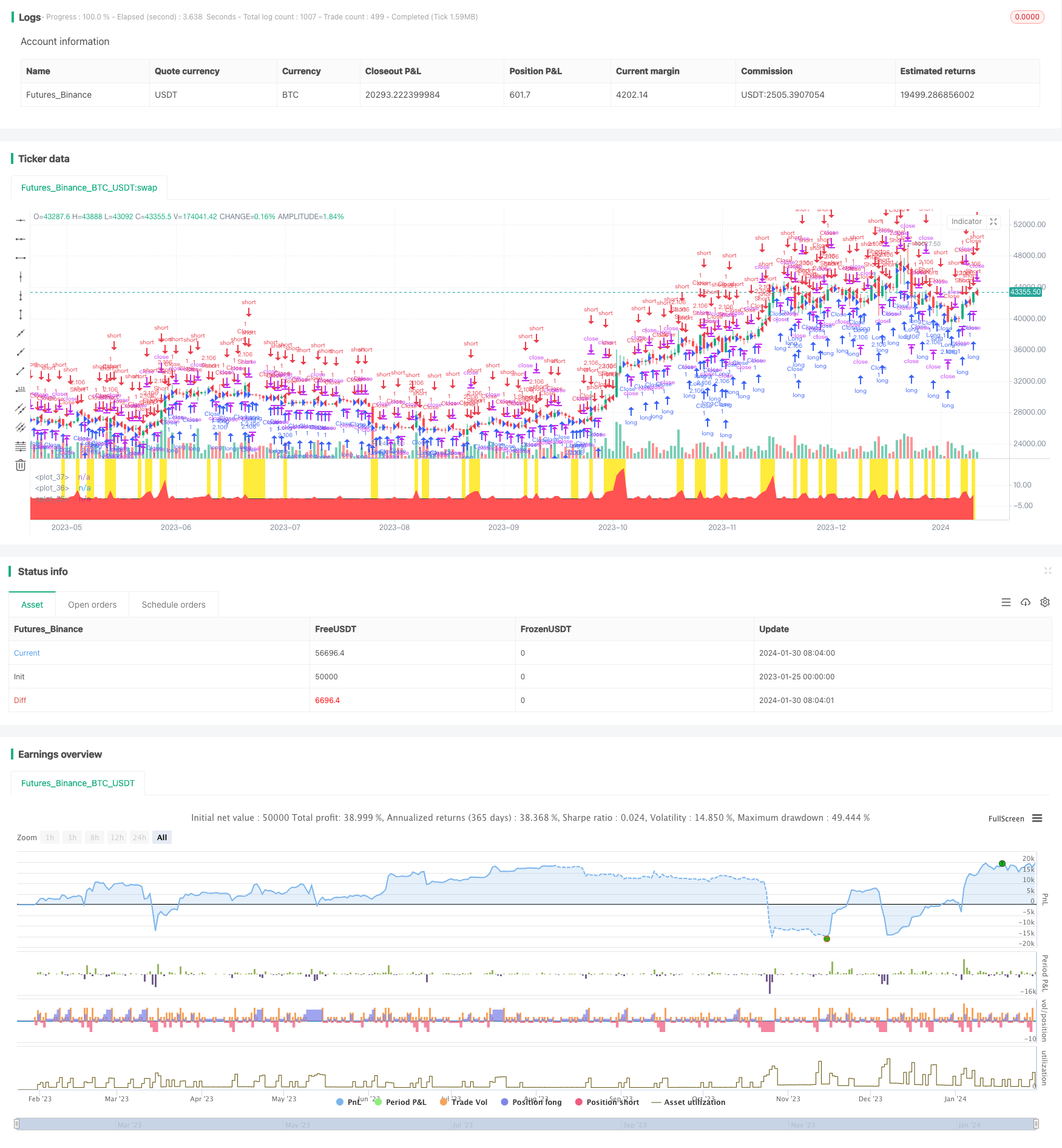
概述
该策略通过计算最后一个涨停价和最后一个跌停价,结合当前价格判断价格是否进入某个定域,从而产生交易信号。当价格超过上一个涨停价一定比例时做多,当价格低于上一个跌停价一定比例时做空。
策略原理
策略首先计算最后一个涨停价lastbull和最后一个跌停价lastbear。然后计算当前价格close相对于lastbull的变化比例ddl,以及相对于lastbear的变化比例dds。
当ddl低于配置的做多信号阈值signallong时产生做多信号up,当dds高于配置的做空信号阈值signalshort时产生做空信号dn。
收到做多信号时若需做多参数needlong为真就开多仓,收到做空信号时若需做空参数needshort为真就开空仓。开仓系数capital由账户权益计算。
平仓条件是开多仓后价格上涨就平多仓,开空仓后价格下跌就平空仓。
优势分析
该策略结合趋势和区间判断,既能捕捉趋势也能利用区间突破产生交易信号,做多做空切换灵活。相比简单趋势跟踪策略,它可以在盘整区间突破后快速捕捉新的趋势方向。
参数可配置空间大,可以灵活调整做多做空的参数,适应不同品种。可以配置开仓时间段来避开重要时间节点。
风险分析
策略中没有止损机制,无法有效控制单笔损失。品种交易范围波动较大时,仓位计算易受价格影响。
可以设置止损来限制单笔损失。可以根据不同品种设置仓位算法使仓位更稳定。
优化方向
- 增加移动止损来控制单笔损失风险
- 改进仓位计算方法,例如用ATR计算,使仓位大小更稳定
- 增加开仓过滤,例如突破黄金交叉时才开仓
- 结合多个品种交易,设定关联关系,降低系统性风险
总结
该策略整合趋势判断和区间突破产生交易信号,既能捕捉新的趋势方向又能利用区间震荡特征。参数设置灵活,可调整空间大,适合不同品种。策略优化空间较大,可从多角度进行改进以适应更复杂的市场环境。
策略源码
/*backtest
start: 2023-01-25 00:00:00
end: 2024-01-31 00:00:00
period: 1d
basePeriod: 1h
exchanges: [{"eid":"Futures_Binance","currency":"BTC_USDT"}]
*/
//Noro
//2019
//@version=4
strategy(title = "Noro's DDL Strategy", shorttitle = "DDL str", overlay = false, default_qty_type = strategy.percent_of_equity, default_qty_value = 100, pyramiding = 3)
//Settings
needlong = input(true, title = "Long")
needshort = input(true, title = "Short")
capital = input(100, defval = 100, minval = 1, maxval = 10000, title = "Lot")
signalshort = input(3.0, title = "Short, %")
signallong = input(-3.0, title = "Long, %")
fromyear = input(1900, defval = 1900, minval = 1900, maxval = 2100, title = "From Year")
toyear = input(2100, defval = 2100, minval = 1900, maxval = 2100, title = "To Year")
frommonth = input(01, defval = 01, minval = 01, maxval = 12, title = "From Month")
tomonth = input(12, defval = 12, minval = 01, maxval = 12, title = "To Month")
fromday = input(01, defval = 01, minval = 01, maxval = 31, title = "From day")
today = input(31, defval = 31, minval = 01, maxval = 31, title = "To day")
//Levels
bull = close > close[1] ? 1 : 0
bear = close < close[1] ? 1 : 0
lastbull = 0.0
lastbull := bull ? close : lastbull[1]
lastbear = 0.0
lastbear := bear ? close : lastbear[1]
//Signals
ddl = ((close / lastbull) - 1) * 100
up = ddl < signallong
dds = ((close / lastbear) - 1) * 100
dn = dds > signalshort
//Lines
plot(dds, style = plot.style_area, color = color.red, transp = 0)
plot(ddl, style = plot.style_area, color = color.lime, transp = 0)
plot(0, color = color.black, linewidth = 2, transp = 0)
//Background
col = (up and needlong) or (dn and needshort) ? color.yellow : na
bgcolor(col, transp = 20)
//Orders
lot = 0.0
lot := strategy.position_size == 0 ? strategy.equity / close * capital / 100 : lot[1]
truetime = true
if up
strategy.entry("Long", strategy.long, lot, when = needlong and truetime)
if dn
strategy.entry("Short", strategy.short, lot, when = needshort and truetime)
if strategy.position_size > 0 and close > open
strategy.entry("Close", strategy.short, 0)
if strategy.position_size < 0 and close < open
strategy.entry("Close", strategy.long, 0)